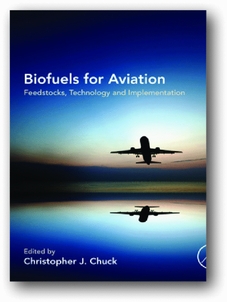
Air traffic is estimated to be rising by some 5% per year, and exponentially thereafter, yet petroleum, the conventional source of jet fuels, has a life index of a mere 50 years. Since hydrogen fuel and all-electric propulsion are still long-term prospects (12,000 Wh/kg for jet fuel cf. 200 Wh/kg for best batteries), supplementation of jet fuels by energy-dense liquids is essential. Of the various alternative sources (e.g. coal and natural gas), only biomatter offers perpetual availability, with the bonus of absorbing atmospheric CO2 during growth. Hence, there is a need for a comprehensive, authoritative review of the procurement, properties and performance of bio-derived jet fuels.
Dr. Chuck's book provides exactly that. This book comprises 15 presentations by specialists in the various fields of the biofuel scene. It indicates that biofuels have been directed initially to road transport, but attention should now be focused on aviation where maximum range between refuellings is crucial. This situation would be eased following further electrification of road transport. Potential biofuel sources include oils of palm, coconut, babassu, camelina, jatropha and linseed, together with seaweed, organic wastes and several algae, the selection depending upon the location, with additional treatment such as pyrolysis, transesterification, Fischer-Tropsch (F-T) syntheses of syngas, isomerisation of alkanes, synthesis of aromatics and hydrotreatment of alkenes, together with catalysts, microbes and/or additising to meet the stringent requirements of the standard specifications. These treatments include the alcohol route and the metabolic conversion of carbohydrates with cell factories, but all are subject to the acid tests of yields and economics. Agricultural wastes are particularly attractive for this reason, and further developments are expected in catalysis.
Broadly, supplemental jet fuels are free of smoke-producing aromatics and corrosive sulphur, but a minimum of 8% aromatics is a current requirement to eliminate fuel-system leakage through seal shrinkage and some sulphur compounds act as natural lubricity enhancers. Although fatty acid methyl esters (FAME) used for road diesel engines have been considered unsuitable for aviation, later research indicates that the property tests used did not cater for oxygen-containing molecules; hence, this criticism may no longer hold.
Currently, synthetic jet fuel produced by F-T processes is acceptable in standard specifications to the extent of 50% by volume (semi-synthetic) and 100% (fully synthetic).
Two case studies are included. The study relating to the UK recommends wastes, residues and low-value feedstocks, and predicts that, by year 2050, replacement of conventional jet fuel by bio-jet is likely to reduce greenhouse gas emissions, particularly CO2, by 24%. For Brazil, the roadmap has excellent prospects with the availability of land, sugarcane and eucalyptus, together with soybeans, sugar, cellulose and oil crops, but some subsidies would be needed initially.
A clear message emerges that those involved in the biofuel industry adhere to the responsible and moral philosophy that biofuels must not impact on the resources of food and demands for land or water, nor lead to atmospheric pollution or deforestation, but since excesses have occurred already, the whole operation should be subjected to Life Cycle Assessments, and controlled by internationally binding political legislation.
There are two Appendices, dealing with Jet Fuel Specifications and Commercial Biofuel Flights.


